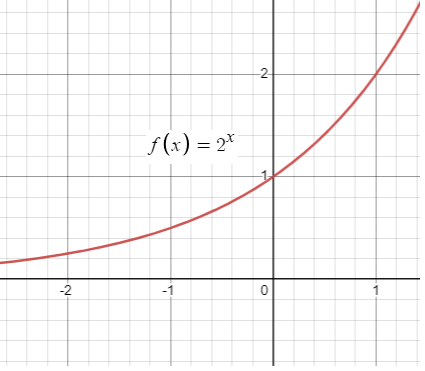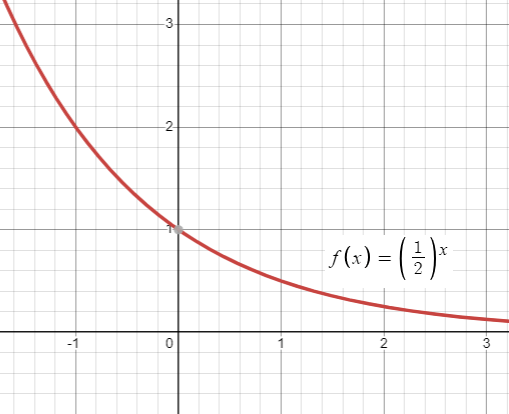IDENTIFYING THE CHARACTERISTICS OF EXPONENTIAL FUNCTIONS
Exponential functions will be in the form f(x) = abx
where a ≠ 0 and b may be
- b > 1, then it must be exponential growth function.
- 0 < b < 1, then it must be a exponential decay function.
Identifying exponential growth and decay from graph
While observing the graph from left to right,
- If it is goes up, then it must be exponential growth function.
- If it is goes down, then it must be exponential decay function.

In other words, it is known as increasing function. Concave up.

In other words, it is known as decreasing function. Concave down.
Reflection with exponential function
If the function is in the form f(x) = -abx
- then the reflection is done across x-axis.
If the function is in the form f(x) = ab-x
- then the reflection is done across y-axis.
Answer the questions for each exponential function.
Problem 1 :
f(x) = 7(2x)
a) Is the function increasing or decreasing
b) Is the function concave up or down
c) Find lim x->-∞ f (x)
d) Find lim x->∞ f (x)
Solution :
f(x) = 7(2x)
Here a = 7 and b = 2 > 1, it must be exponential growth function.
a) Since it is exponential growth function, it is increasing function.
b) Concave up
c) Horizontal asymptote is y = 0 or x-axis.
Domain is (-∞, ∞) and range is (0, ∞)
lim x->-∞ f (x) = 0
d) lim x->∞ f (x) = ∞
Problem 2 :
f(x) = -4(5x)
a) Is the function increasing or decreasing
b) Is the function concave up or down
c) Find lim x->-∞ f (x)
d) Find lim x->∞ f (x)
Solution :
f(x) = -4(5x)
Here a = 4 and b = 5 > 1, it must be exponential growth function. Since we have negative coefficient, it must be reflection about x-axis.
a) It is decreasing function.
b) Concave down
c) Horizontal asymptote is y = 0 or x-axis.
Domain is (-∞, ∞) and range is (0, -∞)
lim x->-∞ f (x) = 0
d) lim x->∞ f (x) = -∞
Problem 3 :
f(x) = (0.2x)
a) Is the function increasing or decreasing
b) Is the function concave up or down
c) Find lim x->-∞ f (x)
d) Find lim x->∞ f (x)
Solution :
f(x) = (0.2)x
Here a = 1 and b = 0.2 in between 0 to 1, it must be exponential decay function.
a) It is decreasing function.
b) Concave up
c) Horizontal asymptote is y = 0 or x-axis.
Domain is (-∞, ∞) and range is (0, ∞)
lim x->-∞ f (x) = ∞
d) lim x->∞ f (x) = 0
Problem 4 :
f(x) = -6(0.8x)
a) Is the function increasing or decreasing
b) Is the function concave up or down
c) Find lim x->-∞ f (x)
d) Find lim x->∞ f (x)
Solution :
f(x) = -6(0.8x)
Here a = 6 and b = 0.8 in between 0 to 1, it must be exponential decay function. Since we have negative coefficient, it must be the reflection across x-axis.
a) It is decreasing function.
b) Concave down
c) Horizontal asymptote is y = 0 or x-axis.
Domain is (-∞, ∞) and range is (0, -∞)
lim x->-∞ f (x) = 0
d) lim x->∞ f (x) = -∞
Problem 5 :
f(x) = 6(1/9)x
a) Is the function increasing or decreasing
b) Is the function concave up or down
c) Find lim x->-∞ f (x)
d) Find lim x->∞ f (x)
Solution :
f(x) = 6(1/9)x
Here a = 6 and b = 1/9 in between 0 to 1, it must be exponential decay function.
a) It is decreasing function.
b) Concave up
c) Horizontal asymptote is y = 0 or x-axis.
Domain is (-∞, ∞) and range is (0, ∞)
lim x->-∞ f (x) = ∞
d) lim x->∞ f (x) = 0
Problem 6 :
f(x) = -(0.4)x
a) Is the function increasing or decreasing
b) Is the function concave up or down
c) Find lim x->-∞ f (x)
d) Find lim x->∞ f (x)
Solution :
f(x) = -(0.4)x
Here a = 1 and b = 0.4 in between 0 to 1, it must be exponential decay function. Since we have negative coefficient, it must be the reflection across x-axis.
a) It is increasing function.
b) Concave down
c) Horizontal asymptote is y = 0 or x-axis.
Domain is (-∞, ∞) and range is (0, -∞)
lim x->-∞ f (x) = -∞
d) lim x->∞ f (x) = 0
Problem 7 :
The exponential function 𝑓 is defined by f(X) = abx, where a and b are positive integers.

Which of the following statement is true ?
(A) 𝑓 demonstrates exponential decay because 𝑎 > 0 and 0 <𝑏< 1.
(B) 𝑓 demonstrates exponential decay because 𝑎 > 0 and 𝑏 > 1.
(C) 𝑓 demonstrates exponential growth because 𝑎 > 0 and 0 < 𝑏 < 1.
(D) 𝑓 demonstrates exponential growth because 𝑎 > 0 and 𝑏 > 1.
Solution :
Every exponential function will be in the form f(X) = abx
From the table, applying the points (0, 40) and (1, 20), we get
f(0) = ab0
40 = a(1)
a = 40
Then f(x) = 40 bx
Applying (1, 20), we get
20 = 40(b)1
b = 1/2
a > 1 and b lies in between 0 and 1.
Exponential decay and option A is correct.
Recent Articles
-
Finding Range of Values Inequality Problems
May 21, 24 08:51 PM
Finding Range of Values Inequality Problems -
Solving Two Step Inequality Word Problems
May 21, 24 08:51 AM
Solving Two Step Inequality Word Problems -
Exponential Function Context and Data Modeling
May 20, 24 10:45 PM
Exponential Function Context and Data Modeling